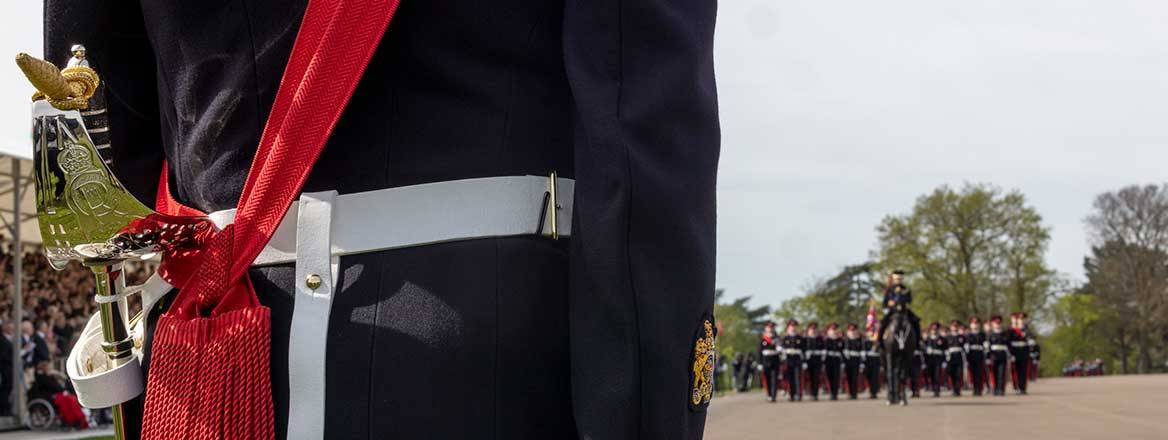A Vital Springboard: The Future of University Officer Training Corps
The British Army faces a crucial decision on officer training, with a danger that the wrong response to short-term pressures on RMA Sandhurst and University Officer Training Corps may damage both the Army Reserve officer pipeline and the capacity for long-term force expansion.
A key dilemma for the UK’s cash-strapped Army is whether to focus on maximising its capability to fight once for a limited period or on projecting force in a continuing major war. A speech in January last year by the then Chief of the General Staff, General Sir Patrick Sanders, moved the spotlight to the latter. The current Minister for Veterans, Al Carns, spoke in a similar vein at a recent RUSI conference. Both cited past major wars and the experience today in Ukraine. Hints are emerging that a similar view will be reflected in the Strategic Defence Review when it is published.
Central to any expansion is how to recruit, train and expand the officer corps. Officers take much longer to select and train than soldiers, and without good officers an army cannot perform.
Before both world wars, Royal Military College Sandhurst and Royal Military Academy Woolwich provided regular officers. They were amalgamated after the Second World War into the Royal Military Academy Sandhurst (RMAS). Meanwhile, university Officers’ Training Corps (UOTCs) provided officers for the Territorial Army and directly for much of the new forces, with temporary Officer Cadet Units (First World War) and Officer Cadet Training Units (Second World War) providing the balance.
Today, officer training is divided between RMAS, which provides all regular training, and UOTCs, which provide the first half of a reserve officer’s training. RMAS also provides an alternative for the first half and sole provision for the second. Under the current system, RMAS commands all UOTCs and certifies their training.
Officers take much longer to select and train than soldiers, and without good officers an army cannot perform
The Army is currently canvassing a proposal that UOTCs withdraw from formal officer training and that RMAS become the sole provider, leaving UOTCs to either provide basic reserve soldier training or even just become a taster experience to encourage people to join the Army. This article looks at the impact of this proposal on today’s Army Reserve and on the Army’s ability to expand in a future war.
The background to the proposal is that RMAS was put in charge of UOTCs a decade ago and, in 2015, the post of Deputy Commandant RMAS was created as a reservist brigadier to supervise reserve training at RMAS, and crucially to ensure that UOTCs delivered the training young officers in the reserves would need.
Some years later, as part of a wider reorganisation, this post was downgraded to full colonel level. Soon afterwards, the summer course dates for reserves were shifted, preventing students from doing a full course at RMAS unless they had done the first two modules of a UOTC (because these were now only available in term time at most universities). More recently, supervision of UOTCs was switched to a newly created post for a regular full colonel. Inevitably, given that most UOTCs are commanded by regular officers, this led to a change in emphasis away from the training of officers for the reserves.
So, the combined effect of the shift in dates at RMAS – which has taken place – and the proposed end of officer training in UOTCs would effectively shut most students out of officer training altogether. Yet given the high proportion of young people who go to university, and the fact that they are typically ‘poor in pocket but rich in time’, students seem even more critical as a source of reserve officers than in the past.
The deteriorating situation was highlighted last summer when RMAS announced that it needed help from AR units and UOTCs to avoid downsizing its summer short course. Despite short notice, offers of help were forthcoming, but the course was downsized anyway, with candidates from UOTCs turned away at the last moment. Only 80 officers passed out, including Regular professionally qualified officers – the smallest number on a summer course for several years.
This is in sharp contrast to the UK’s English-speaking counterparts. Both the US and Australia provide - and plan to continue to provide - a distributed model. In the US, training for the Active Army, the National Guard and the federal US Army Reserve is spilt between West Point, Reserve Officers’ Training Corps (ROTCs) and Officer Cadet Schools, with some direct reservist commissions. In Australia, regular officer training is provided by RMAS Duntroon, while Army Reserve training is split across several University Regiments.
The UOTC issue is part of a wider one across all training as to whether to concentrate individual training in single locations or distribute it more widely with central certification. For reasons both of cost and training assurance, in the UK, the Regular Army has moved steadily towards preferring concentration.
Indeed, there is another damaging proposal circulating: that the Army Training Units (ATUs), which deliver regional courses for a range of soldier skills, be phased out and that soldiers – even from the most distant parts of the UK – should do the courses that the ATUs currently deliver at the arms schools.
Excessive concentration is damaging the Army Reserve, both because of the time wasted travelling from distant parts of the UK for short training periods and because training in units helps to build cohesion. Equally important is that having distributed sites is central to getting structures in place for expansion. Indeed, the Reserves Forces Review 2030 called for the establishment of local hubs to deliver ‘collaborative distributed training’ (and other functions such as mobilisation).
Distribution also avoids offering easy targets to the enemy in the build-up to war. A single point of delivery for officers would offer a tempting target indeed for a wide range of systems, from kinetic attack to chemical, biological or cyber, creating a single point of failure for building a citizen army in a reasonable timeframe. So, the decision on the future of UOTCs really is central as to whether or not the UK is interested in sustaining an army in a long war or simply wants to use the limited resources available for one brief campaign.
The decision on the future of UOTCs really is central as to whether or not the UK is interested in sustaining an army in a long war or simply wants to use the limited resources available for one brief campaign
Without the focus of formal officer training, it is not clear what the purpose of UOTCs will be. The common military syllabus is not demanding – anecdotally, its lack of challenge is one of the reasons reserve recruits drop out. It is hardly accidental that the two principal units which are empowered to deliver their own Phase 1 training, and to a more demanding standard – 4 Para and the Honourable Artillery Company – are both heavily overstrength.
The main focus may shift in the eyes of students to socialising and adventure training, which may not attract those most likely to make good officers. Instead, the UOTCs may foster a damaging perception that the Army does not offer value for money, running counter to their underlying purpose – and at a sensitive time. Delivering officer training provides a clear purpose and structure, with demanding goals which students can test themselves against and an impressive result to show prospective employers.
UOTCs have a further valuable aspect. They often promote an early mutually beneficial crossover between the Regulars and Reserves. There are numerous examples of Officer Cadets destined for the Regulars serving with the Reserves while at UOTCs, then joining the Reserves upon leaving the Regulars. Maintaining links with past cadets can encourage this.
Indeed, the UK could move forward and increase the value Defence gets from UOTCs by improving alumni arrangements for each of them. This would make them fertile ground for later reserve officer recruiting, once former cadets have settled into their civilian careers, and provide a network of contacts in the wider civilian world for both regular and reserve officers. Funding would be minimal, with events self-funding.
The best solution would be to keep officer training at UOTCs and restore the summer course dates at RMAS to July/August, so students have a choice of the UOTC route or ‘zero to hero’. The post of Deputy Commandant (Reserves) should be revived and, crucially, control of UOTCs should be restored to reservist control.
Positive change may be on the way. The new commandant at RMAS has made a good start in blocking the practice of cadets, with imminent places booked for regular commissioning courses, attending the short course first to improve their financial position (even sometimes taking places from the reserve officers who should have been there). Cadets planning a regular commission who have time to serve in a reserve unit or UOTC first often offer good value, but it is a good sign that RMAS has recognised that there must be return of service to the Reserve to justify taking a sometimes scarce place on a short course.
UOTCs provided some of the best officers in both world wars. Field Marshal Bill Slim was a Territorial Officer commissioned from Birmingham UOTC; George C Marshall was commissioned from Virginia Military Institute ROTC (independent of the then US War Department and today’s Department of Defense); and General Sir John Monash, the great ANZAC Corps commander in the First World War, was commissioned from Melbourne University Regiment.
UOTCs should remain officer training establishments providing at least half of the training required for a reserve officer in order to maximise routes to a reserve commission, and to provide a framework for expansion in times of tension – as well as focused goals for every student who joins.
© Julian Brazier and Henry Sugden, 2025, published by RUSI with permission of the author
The views expressed in this Commentary are the authors’, and do not represent those of RUSI or any other institution.
For terms of use, see Website Ts&Cs of Use.
Have an idea for a Commentary you’d like to write for us? Send a short pitch to commentaries@rusi.org and we’ll get back to you if it fits into our research interests. Full guidelines for contributors can be found here.
WRITTEN BY
Sir Julian Brazier
Distinguished Fellow
Lt Col Henry Sugden
- Jim McLeanMedia Relations Manager+44 (0)7917 373 069JimMc@rusi.org



